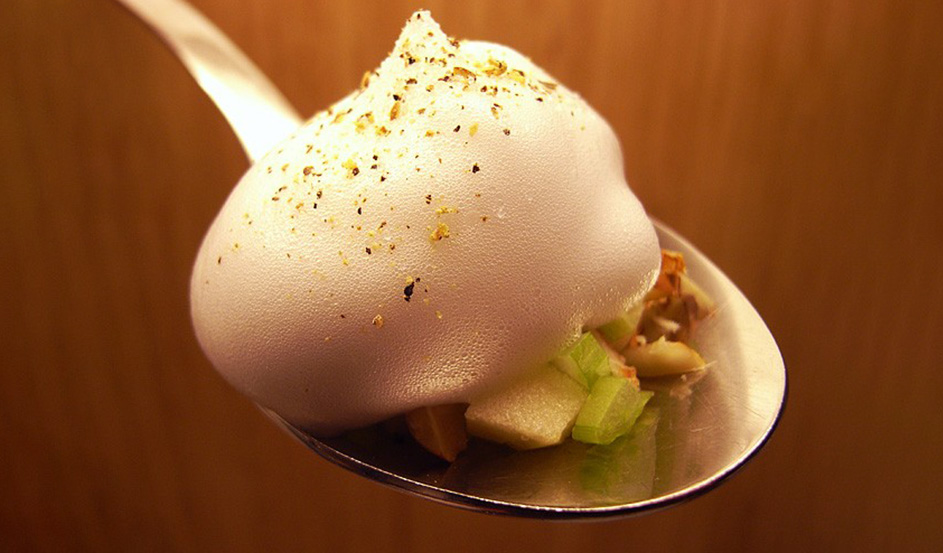
LECITHIN & CULINARY FOAM
Lecithin is ideal for making airs, foams, mousses and emulsions. Most commercial lecithin is extracted from soybeans making it both vegetarian and vegan friendly. Lecithin contains both hydrophobic (water-hating) and hydrophilic (water-loving) groups, so it can also be used in making emulsions. Under normal circumstances oil and water do not mix and separate out, creating two distinct layers, but an emulsifier such as lecithin helps to combine these two layers, creating a more stable preparation.
Lecithin is typically derived from soy bean as a by-product of creating soy based vegetable oil. Lecithin is extracted from hulled cooked soy beans by crushing the beans and then mechanically separating out (via extraction, filtration and washing) crude lecithin. The crude lecithin is then either enzymaticaly modified. Lecithin can also be derived from animal sources, such as eggs and animal proteins but animal derived lecithin is more expensive than plant derived lecithin so it’s less common and plant lecithin is more commonly used. (Cooking for Geeks: Real Science, Great Hacks, and Good Food by Jeff Potter).
Emulsions: When added to a mixture of oil and water, the hydrophobic groups naturally surround the oil droplets, while the hydrophilic parts bonds with and stabilises the water, producing a stable emulsion.
Foams & mousses: When a water based liquid is whisked, the hydrophilic water molecules remain in contact and held to the hydrophilic part of the lecithin molecule, leaving the hydrophobic part to surround and stabilise the air bubbles incorporated by the whisking.
By weight soya lecithin should be used in a concentration of 0.3-0.8% for foam and 0.5 to 1% for emulsions. As an emulsifier, it can be whisked into the chosen liquid; while for foams or mousses, a stick blender held just below the liquid’s surface creates maximum yield. The resultant foam can then be spooned off and served or even frozen to create a novel texture.
A culinary foam consists of natural flavours such as fruit juices or vegetable purees, soup and stock bases mixed with gelling or stabilising agents such as lecithin, gelatine or natural fats in cream and other dairy produce .This is achieved by the introduction of air by using either a mechanical technique of whipping the fluids with either a hand held immersion blender or extruded through a cream whipper using N2O cartridges.
This technique is not new to us and has been used for many generations such as the making of cappuccinos and the old childhood favourite for adding a topping to an Ice-cream Sunday. Ferran Adrià has taken this 1970’s technique and equipment, refined the philosophy and used the science behind it all to develop the more commonly used culinary foams, airs and espumas that we all know these days.
In the ‘90s, when Adrià developed this technique it took the culinary world by storm and and it was considered avant-garde at that time. Then foams were used in the white-tablecloth establishments around the world and became totally over used.However who cares if foams are so ‘yesterday’ in the restaurant world? I still love the technique and think it’s definitely one to retain. It shows that the culinary world is turning and we are not all stuck in obeying the classic French school of cooking . I class it as a cookery technique developed and learnt in my cookery era and I’m proud of it and shall celebrate it for as long as I can.
The benefits of this technique is that when you incorporate air mechanically, in a fierce manner, into a very intense and strong flavoured sauce you expand the flavour so it becomes light and sumptuous and the volume doubles.
As briefly explained before there are two kinds of foams. I differentiate the two as follows:
1. The one that I refer to as a foam or cappuccino is made with a hand held immersion blender creating a wispy foam,
2. The other foam, espuma or air ,is created by a cream whipper, also known as a siphon, using N2O cartridges to incorporate the air which creates a dense mousse type foam.
Which foam to use and when is a matter of personal preference. To create the perfect foam or air it is important that you have a understanding of how to achieve this and I have listed a few facts that should set you on your way.
Espuma and Foaming facts:
- The liquid or puree must be thick and or dense enough to hold its shape.
- For the foam to hold its shape for a period of time there must be some form of thickening or gelling agent present in the liquid.
- Thickening and gelling agents are: gelatine, lecithin, agar and natural fats such as butter, cream and other dairy produce
* For hot foams the best thickeners are fat or starch; this could be found in butter, cream or milk. It’s also important to make sure that the liquid is not too hot, the perfect temperature is between 5o°C and 65°C. Place the cream whipper in a bain-marie filled with hot water; do not keep for longer than 2 hours.
* Cold foams also require fat to stabilise the shape but if you make dairy free foam you can use gelatine with dense liquid or purees, to stabilise the foam. All depends on what you are making but I normally use 1 leaf of gelatine to 250ml of dense liquid. If your choice is dairy you can add fat by adding yoghurt, crème fraîche or cream.
* There are two different gasses available to charge the cream whipper . Standard gas bulbs that will give you the foaming characteristics are Nitrous oxide (N2O) .
* Carbon Dioxide (CO2) is also available and will give the liquid a fizzy texture commonly found in fizzy drinks. Select your gas carefully to give you the desired end result. If you would like to experiment with making fizzy soda drinks I recommend that you should investigate the Soda Siphons bottles.

